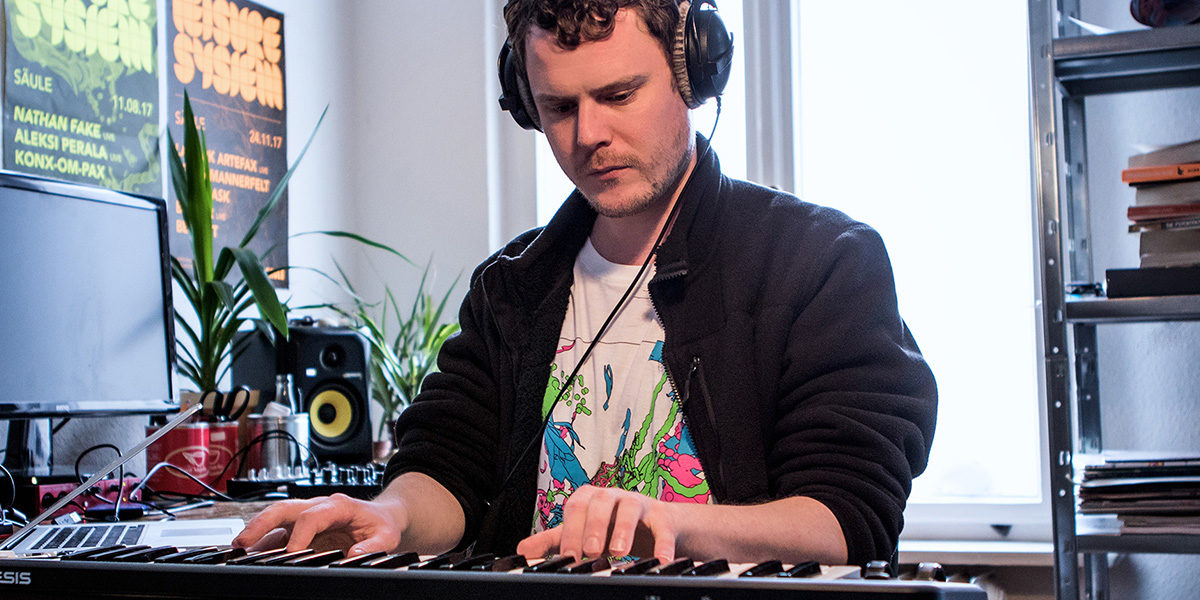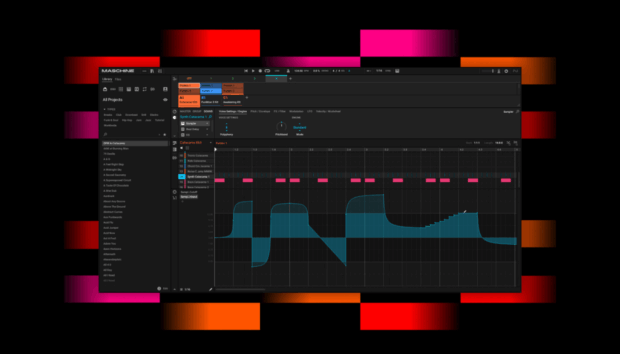
In DJ technology terms, TRAKTOR has had a long history of innovation, born of a pedigree that included successful audio production tools such as REAKTOR, and audio effects plug-ins such as GUITAR RIG, as well as others. Much of TRAKTOR‘s evolution, including the library of DJ effects, powerful syncing capabilities, and user interface, came from a knowledge gained thanks to all of the products made by Native Instruments.
It makes sense that forward-thinking producers have experimented with using TRAKTOR as part of their studio setup, not just for playing music, but for processing audio and manipulating sound. TRAKTOR’s spontaneity and ease of use makes it ideal for quickly dipping in and out of, with instant results when using up to four banks of three effects chains.
exael, Konx-om-Pax, and Huerco S. are part of a community that have incorporated TRAKTOR into their production workflow, from sketching out ideas, to running the track through final effects processing, and learning from each as they progress. “I’ve been using Traktor on and off as a production tool since about 2015, after both Shy [Uon] and Brian [Huerco S.] had mentioned they’d been using it to construct tracks and add effects,” says exael.
Blending
For Berlin-based exael, TRAKTOR allows the producer to create a more organic aesthetic to their ambient-experimental techno, both through experimentation and testing out track structure. “I use Traktor to get a real-time feel for how long certain elements should repeat or when I should bring in a new element, something that isn’t always easy with [Digital Audio Workstation tracker software] Renoise.”
Like exael, DJ and visual artist Konx-om-Pax also uses TRAKTOR to sketch and jam with, to discover how elements of the music might fit together. “I mainly use it to test out how my tracks mix with other people’s music. Sometimes I find a loop that sounds great in real-time which wouldn’t happen in [Ableton] Live because of the non-instant playback. TRAKTOR is better to capture those spur of the moment ideas to record as sketches.”
House and ambient electronica producer Huerco S. records jam sessions in a more traditional manner, and then uses TRAKTOR to hunt for elements to build and layer the track further. “Over the years I have had two different setups, one being FL Studio, the other being an assortment of hardware I use and then edit [the near final track] in TRAKTOR.” he says.
“I usually start by recording longer form jams, improv stuff from hardware into Audacity, or something like that, then take said jam and throw it into TRAKTOR. I find it to be easier to find loops this way and you can really hone in on something interesting very quickly.” He also explains that messing with the sound garners interesting results. “Pitching the track up or down, focusing on such small portions of the longer piece through the use of looping you can emancipate these sections, giving them new life.”

Decks and effects
If there’s one area of TRAKTOR’s feature set that really shows off how versatile it is and how much it can help differentiate your tracks from the crowd, then it would have to be the 40+ professional deck and eight mixer effects. In fact, many of these are TRAKTOR’s own take on what you’d hear in your favorite DAW: delays, reverbs, and filters that give producers creative control of their music.
A healthy obsession with one specific deck effect gives Huerco S. his creative inspiration: Auto Bouncer. “I can’t emphasize enough how much I use this one, I think the next record I release will be as ‘Auto Bouncer,’ haha. It’s a lovely ramp-sort of delay that I used throughout my last album as Pendant, Make Me Know You Sweet. I also heavily use the Filter LFO and Transpose Stretch for movement.”

While in the studio, TRAKTOR’s flexible effects units and customizable user interface help Huerco S. stay loose with the workflow. “I definitely change the FX chain and make full use of the four channel advanced view, allowing me use of pitch, EQ, and volume for each deck. It’s very important to have all four channels in use. It’s a sort of DJ set with one’s own stems.”
exael’s method is to really get in there and mangle the sound. “The Reverse Grain can yield some pretty trippy results, and I’ve been playing a bit more with the Beat Smasher recently.” But there’s also room for subtlety with some of the more airy effects. “I really like the Ring Mod and Flanger effects, they’re nicely made and make things sound more metallic without sounding too cheesy. The Reverb is super creamy and warm as well.”
For Konx-om-Pax, effects are a great means to play with rhythm in the track. “I like the Delay TS and Auto Bouncer.”
“I processed a drum break using Auto Bouncer for my track ‘Optimism Over Despair‘”, he adds. “It totally messes with the pitch in a weird way. It reminds me of a lot of extreme computer music stuff that I listen to.”
A great technique to harness TRAKTOR’s four decks, is to load up individual stems or jam elements into each one, and just go for it. As exael puts it, “Another way I use TRAKTOR is to throw some stems/riffs/ideas from unfinished recordings and try to mix them together. If I have a stem that is unquantized or really arrhythmic, the BPM that it gets read at can lead me to some combinations with other sounds I might not have thought of.”
The color and shape
There’s also potential to harness TRAKTOR’s audio processing to give the sound some desirable color before mastering. exael runs finished tracks through the software as a sort of very light compressor. “TRAKTOR is also super nice for adding more character to finished tracks, especially for clubbier productions; it’s baseline compression makes things sound nice and fat, and can glue shit together well.”
The common strand between all these approaches is that TRAKTOR offers quick and simple way to try out ideas and increase serendipity. If you look beyond the effects and sound processing, TRAKTOR’s four decks and rock-solid beat syncing create more stability while you play with your music, rather than worry about inter-hardware/software communication.
These three pioneers are opening the door for other such producers to follow. The wealth of features that allow you to process and control music in TRAKTOR PRO 3 provide so many different ways to spice up your productions, like crossing over into using TRAKTOR for performing live, for example. Stem decks, Remix Decks, even the new Mixer FX can provide some motion to a track, testing the sound as it evolves.
Live jamming is something that Huerco S. has already had experience with, in group sessions. “Additionally, friends and I have used TRAKTOR in jam sessions. Without the proper equipment (i.e. MIDI) we end up just picking a BPM and sticking to it in TRAKTOR while we each drop in our own stems, layering them on top of each other and mixing in and out on an external mixing board. We have definitely made quite a few records in this fashion.”
But when you start delving into features like Stems and Remix Decks, you have all your own loops and one-shot samples at your fingertips.
Delving even deeper, there are features like the effects snapshots, and the layout manager which can be tailored to a production workflow. With effects snapshots, you’re able to save your last preset combination for the currently-selected effect, so that next time you return to it, everything will be how you liked it. The layout manager lets you quickly recall different feature panels on the fly. And of course, both are easily MIDI mappable to a free control.
Future of production
And, do these three have any advice for others that might be interested in using TRAKTOR PRO 3 as part of their productions?
Konx-om-Pax: “If you set the auto crossfade to over 90 seconds it makes such a smooth transition you sometimes can’t even notice the tracks changing. Its really handy for doing mixes!”
Huerco S.: “Don’t be afraid to dig in and zoom in, especially when working with longer source audio, the gems are in there. Also to take advantage of the loop in/out adjust feature and to make loops that aren’t 4,8,16,etc bars…gives an organic feel to something that can be inherently mechanical and having fun dissecting audio is always important.”
exael: “I guess my advice would be just to approach using [TRAKTOR] very loosely. Try throwing some unfinished ideas you have into it and start mixing them together and see what happens. It can give you a fresh perspective on what are maybe some older ideas of yours.”
Now, with the recently released Harmonic Mixing 3.2 update for TRAKTOR PRO 3, both DJs and producers can confidently push the music to even further highs and lows. Even before the update, time stretching was already a powerful tool with Elastique 3 allowing for massive shifts in tempo.
As exael puts it perfectly: “The pitch shifting in Traktor is so sick, it has the best resampling of all of the tools I have. Changing the pitch with it doesn’t ever really make things sound too artifacted or choppy.’
photo credits: Konx-om-Pax by Yvonne Hartmann















